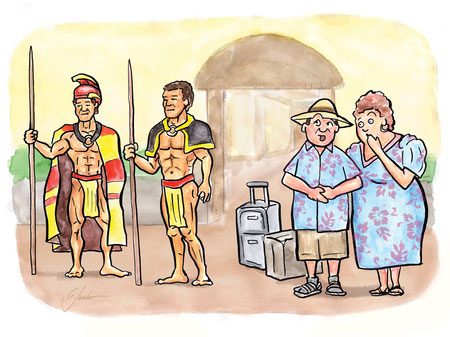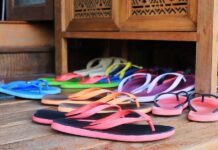Story by Paul Wood
 The great chief strode into the village accompanied by vivid emblems of his authority: the red-and-gold cloak, the spiked woven helmet, two attendants bearing his kahili (feathered standards), plus a retinue of warriors, kahuna (priests) and dancers. Behind him, a young warrior carried the Makahiki banner, a sail-like sheet of white fabric. Some villagers stood proudly with gifts in their arms. On their lips were the pledges they were about to make, pledges to undertake tasks of great importance to the community.
The great chief strode into the village accompanied by vivid emblems of his authority: the red-and-gold cloak, the spiked woven helmet, two attendants bearing his kahili (feathered standards), plus a retinue of warriors, kahuna (priests) and dancers. Behind him, a young warrior carried the Makahiki banner, a sail-like sheet of white fabric. Some villagers stood proudly with gifts in their arms. On their lips were the pledges they were about to make, pledges to undertake tasks of great importance to the community.
And there were other people shuffling past in rubber slippers and beach towels who had no idea what was going on. We were at Ka‘anapali Beach Hotel, on the big lawn that faces the sea, and all of this happened only weeks ago.
The chief and his retinue took positions before a hala grove, and the villagers (so to speak) approached with their gifts. First was the hotel’s general manager, Mike White, draped in a kïhei (shawl). Although Mike is a fifth-generation Island native, the meeting looked odd—Mike slender, Nordic, neatly barbered; the Hawaiians as though they’d just spilled out of a time machine. Yet no one gave the least suggestion, not with a wink or a witticism, that this affair was anything other than the real deal—the socially vital ritual to begin Hawai‘i’s four-month-long Makahiki season, a ritual that’s taken place annually for fifteen centuries (despite some regrettable lapses over the past century or so).
Makahiki means it’s time to come home, call off the wild expeditions and wars, take a few months to make nets, rebuild walls, and spend time with the kinfolk. Time to strengthen the social fabric and repair previous mistakes. It’s a good holiday for all people and times, including a nation bogged in a Wall Street meltdown.
Mike White declared to the chief: “Because I am responsible for my people, I choose the symbolism of food this year. I will make a poi pounder and a poi board and present these to you on February 28th, the last day of Makahiki.”
Other hotel staffers stepped up to promise kapa cloth, fishing nets, old-style weapons—arduous tasks when done (as promised) with mostly pre-Western tools.
Why is this important? The answer can be seen in a cabinet located in the Ka‘anapali Beach Hotel’s lobby, a display of staff-created artifacts from the previous Makahiki season: an octopus lure (by the kitchen staff), a feather lei (Rooms and Reservations Department), pu‘ili (bamboo rattles) made by the bellmen. The chief’s two kahili had been made the previous year by dozens of Filipina ladies from Housekeeping. Someone actually created an adze lashed with coconut fiber.
This cabinet looks exactly like something you would see at Bishop Museum. But the artifacts are not relics of a gone world. They are newer than iPods.
Question: if Mike White makes a poi pounder, is it any less an authentic Hawaiian artifact than one made three centuries ago?
Answer: It has come to such a point that we must stop talking about Hawaiian culture in the past tense. Not “the Hawaiians made poi pounders,” but “the Hawaiians make poi pounders.” A better example: not “the Hawaiians never fished the reef at this time of the month,” but “I never do.”
Radical.
After the ceremony, the chief and his warriors were standing around the front of the hotel, and I happened to overhear a tourist couple.
“Look. Those guys have big sticks!”
“A couple of those guys look. . . . I wouldn’t want to mess with them.”
“This one here, his butt’s bare.”
“All of them have bare butts.”
After a pause: “Is that legal?”
“This is Hawai‘i. I guess so.”





